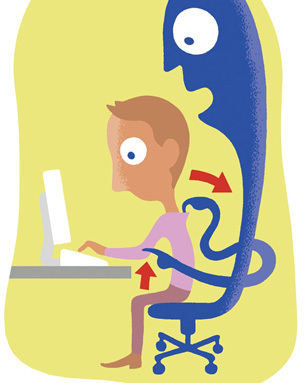 loading
loading
FindingsYour mother would approve Gregory NemecView full image
John Morrell’s latest invention began with tennis elbow. A doctor told the mechanical engineering professor and coinventor of the Segway that his sore arm was caused partly by too much time spent slouching at a laptop, and gave him a prescription: instructions for sitting properly. But following through proved tough. “I could do it for a little while, but then I’d forget,” Morrell says. “I said, ‘We ought to be able to do something about this.’”
So Morrell ’86 and graduate student Jean Zheng came up with the Posture Feedback Chair. It’s a Herman Miller office chair fitted with seven sensors, each half the size of a business card. When the sensors detect that the chair’s occupant is slouching, they’ll give him or her a reminder buzz, courtesy of embedded cell phone vibrators. “It’s a private message,” Morrell says—and a message the recipient responds to instinctively. “Your body is wired to know what being touched on your back means.” What if your problem isn’t tennis elbow but lower-back ache? The chair may still help: it can be tailored to any spine’s bad habits. First a doctor or physical therapist determines your ideal sitting position, and the sensors take a baseline reading of it. After that, deviation from that personal best will provoke the chair’s silent nudges. Morrell presented the chair in March at the 2010 Haptics Symposium, an international conference focused on the science of touch and technology. He and Zheng are planning a series of weeklong tests—three different people, three different Posture Feedback Chairs. Then he hopes to partner with a manufacturer interested in mass marketing a product that can “coach people back to good posture.” Next, a fork that reminds you to eat your vegetables?
The comment period has expired.
|
|